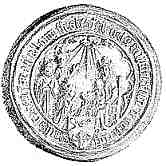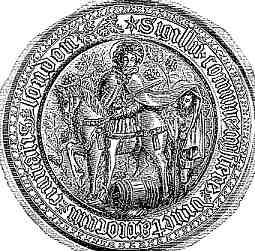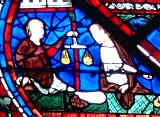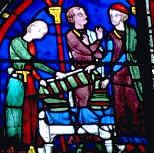






If you are looking at this page without frames, there is more information about medieval writing to be found by going to the home page (framed) or the site map (no frames).
| Seals of Guilds | |||
| Late medieval guilds served a range of functions both secular and religious. Guilds of merchants or craftsmen in the towns served in the regulation of commerce and trade, but also carried out religious functions, such as the presentation of the Mystery Plays in the towns. Town corporations which progressively took over aspects of local government usually had some kind of historical origin in the local merchants' guilds, but also in religious guilds. These last were sometimes organised at a parish level, but also sometimes appeared to act as a sort of medieval Rotary Club, where men of good character assembled under the banner of some saint or other to ensure the welfare of their members. The seals of guilds may therefore contain a combination of religious imagery and that derived from the guild's secular function, often with heraldic flourishes. | |||
 |
Seal of the fullers of Warwick. | ||
| This example, from a craft guild involved in woollen cloth finishing, employs purely religious imagery in the form a depiction of the adoration of the Magi. There is a heraldic device at the bottom of the seal. | |||
| Seal of the Vintner's Company of London, of 1437. |
 |
||
| This example of a merchant guild seal shows the popular religious image of St Martin sharing his cloak with a beggar. The background is filled with grapvines and fruit while a wine barrel lies at his horse's feet. Perhaps the vintners thought that charity should involve the sharing of wine as well as clothing. | |||
 |
|||
| 14th century staple seals of London, Southampton and Boston. Yes, this is a rather scungy picture, sorry. | |||
| The wool staples regulated the export and quality control of this most significant product of late medieval England. These staple seals show an assortment of imagery. That of Lincoln represents the Virgin and Child standing on a woolsack. That of Southampton supposedly shows a leopard's face in a rosette with roses and fleurs de lis. We may have to take that on faith. That of Boston shows its patron saint, St Botolph, standing behind a woolpack. The juxtapostion seems a little strange, but probably no more peculiar than having St Isidore of Seville as patron saint of the internet. | |||
| The depiction of craftsmen or their tools of trade in a religious context mirrors that found in the stained glass windows of Chartres Cathedral, where the guilds that subsidised each window are depicted as part of the imagery. It simply emphasises that religious life was a major part of public or corporate life in the middle ages. | |||
 |
 |
||
 |
 |
||
| Bakers, bankers, drapers and winesellers are just some of the many craft groups that had themselves immortalised in the magnificent 13th century stained glass windows of Chartres. | |||
|
|
|||
|
|
|||
|
If you are looking at this page without frames, there is more information about medieval writing to be found by going to the home page (framed) or the site map (no frames). |
|||